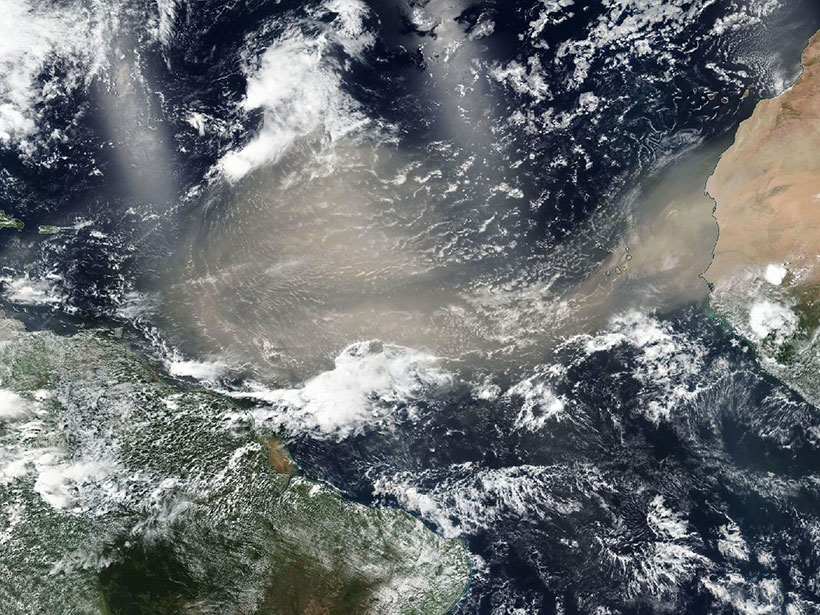Source: Global Biogeochemical Cycles
Huge dust plumes that migrate westward across the Atlantic Ocean, like the historic cloud that swept across from the Sahara desert earlier this summer, can raise air pollution and pose health risks. However, dust from Africa is also an important source of nutrients—especially phosphorus—for soils across the ocean, including in the Amazon Basin.
As deforestation of the Amazon continues and wildfires become more likely with climate change, there is concern that forest soils already depleted in phosphorus may become less fertile, thus reducing the Amazon’s ability to function as a carbon sink for the planet. So the degree to which African dust replenishes soil nutrients continues to be an important area of research.
In a new study, Prospero et al. quantify the amount of dust arriving with trade winds to South America from Africa on the basis of measurements of mineral dust and particles smaller than 10 micrometers in diameter (PM10) in air samples collected at a coastal site in Cayenne, French Guiana, from 2002 to 2017. The researchers’ results suggest that significant amounts of nutrients are deposited with the dust, but they also show that previous studies based on more limited measurements may have greatly overestimated the impact of these nutrients.
Their data closely tracked results from NASA’s Modern-Era Retrospective Analysis for Research and Applications, Version 2 (MERRA-2) model, which provides a global reanalysis of atmospheric aerosols using remotely sensed aerosol data. On the basis of the excellent agreement between MERRA-2 and the long-term observations at Cayenne, the team extended the model to estimate how much dust is deposited to various regions in South America and specifically to the Amazon. They found that the Amazon Basin receives 8–10 million metric tons of dust per year. This estimate, although large, is lower than previous estimates by a factor of 2 or more. The team also found that dust deposition rates are highest in the northern and eastern regions of the Amazon and lowest over southwestern regions where burning is most intense and where soils are most depleted.
The authors conclude that their findings raise questions about the significance of African dust in Amazon ecosystems. They point out, however, that although the MERRA-2 model performed well on the basis of their measurements, uncertainties remain in it and all models. To help resolve these uncertainties, the researchers call for more decadal-scale observations of aerosols and precipitation in South America. (Global Biogeochemical Cycles, https://doi.org/10.1029/2020GB006536, 2020)
—David Shultz, Science Writer
Citation:
Shultz, D. (2020), Trans-Atlantic dusts may not enrich Amazon as much as thought, Eos, 101, https://doi.org/10.1029/2020EO148990. Published on 16 September 2020.
Text © 2020. AGU. CC BY-NC-ND 3.0
Except where otherwise noted, images are subject to copyright. Any reuse without express permission from the copyright owner is prohibited.
Text © 2020. AGU. CC BY-NC-ND 3.0
Except where otherwise noted, images are subject to copyright. Any reuse without express permission from the copyright owner is prohibited.

